American actress Gloria Swanson (1899–1983) is best known for her role as the reclusive silent film star Norma Desmond in Sunset Boulevard (1950). Swanson herself was one of the most prominent stars and fashion icons during the silent film era. She often played under the direction of Cecil B. DeMille, but also produced her own films, including Sadie Thompson (1928). Her fashion, hair styles, and jewels were copied around the world and by the middle 1920s, she was the highest-paid actress in Hollywood. In France she made her personal favourite of all her films, the now lost Madame Sans-Gêne (1925).
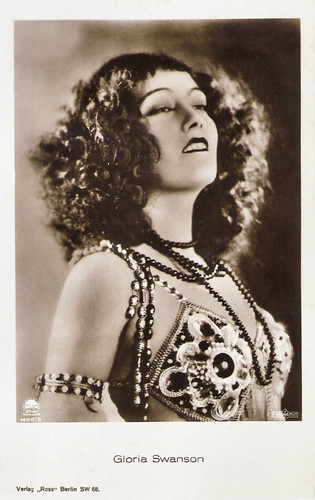
German postcard by Ross Verlag, no. 1488/3, 1927-1928. Photo: Paramount / Parafumet. Publicity still for Stage Struck (Allan Dwan, 1925).
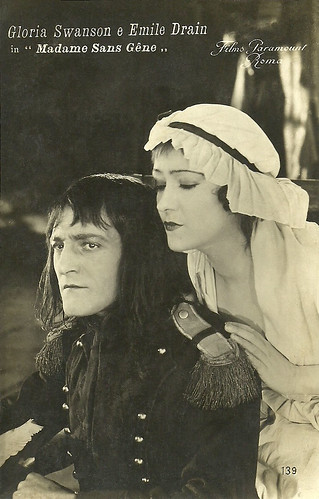
Italian postcard, no. 139. Photo: Films Paramount Roma. Publicity still for Madame Sans-Gêne (Léonce Perret, 1925) with Emile Drain. Collection: Didier Hanson.
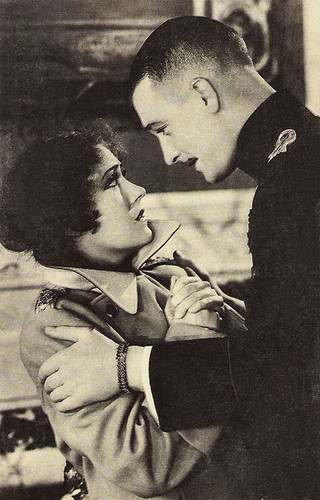
Spanish postcard by Casa Molina, Madrid. Gloria Swanson and Walter Byron in Queen Kelly (Erich von Stroheim, 1929).
Gloria May Josephine Swanson was born in Chicago in 1899 to Adelaide (née Klanowski) and Joseph Theodore Swanson, a soldier. (Some sources list 1897 as the year of her birth.) Because of her father's attachment to the U.S. Army, the family moved frequently and Swanson ended up spending most of her childhood in Puerto Rico, where she learned Spanish. She also spent time in Key West, Florida.
It was not her intention to enter show business, but on a whim one of her aunts took her to a small film company in Chicago called Essanay Studios for a visit and Swanson was asked to come back to work as an extra. According to Wikipedia, she made her film debut there in the short The Song of Soul (1914) and according to Ed Stephan at IMDb in The Fable of Elvira and Farina and the Meal Ticket (Richard Foster Baker, 1915).
After a few months working as an extra, Swanson left school to work full-time at Essanay. She auditioned for the leading female role opposite Charlie Chaplin in His New Job (Charles Chaplin, 1915), but he instead cast her in the brief role of a stenographer. Her parents separated and she and her mother moved to California in 1916. There she appeared in Mack Sennett's Keystone comedies opposite Bobby Vernon.
In 1919 she signed a seven-year contract with Famous Players-Lasky. There director Cecil B. DeMille turned her into a romantic lead in such films as Don't Change Your Husband (1919), Male and Female (1919) with the famous scene posing as ‘the Lion's Bride’ with a real lion, Why Change Your Wife? (1920), Something to Think About (1920), and The Affairs of Anatol (1921).
In only two years, Swanson rocketed to stardom and became one of the most sought-after actresses in Hollywood. She next appeared in a series of films directed by Sam Wood, including Beyond the Rocks (1922) with Rudolph Valentino. Long believed to be a lost film, Beyond the Rocks was rediscovered in 2004 in The Netherlands. In a series of costume dramas, Swanson became the screen's first clotheshorse, ornamented with beads, jewels, peacock and ostrich feathers, and other extravagant pieces haute couture of the day.
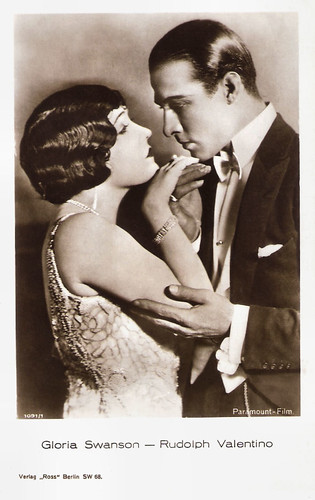
German postcard by Ross Verlag, Berlin, no. 1091/1, 1927-1928. Photo: Paramount-Film. Publicity still for Beyond the Rocks (Sam Wood, 1922) with Rudolph Valentino.
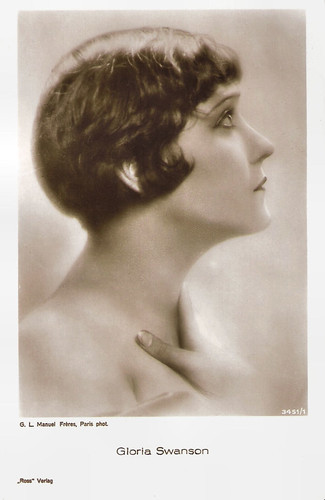
German postcard by Ross Verlag, no. 3451/1, 1928-1929. Photo: G.L. Manuel Frères, Paris.
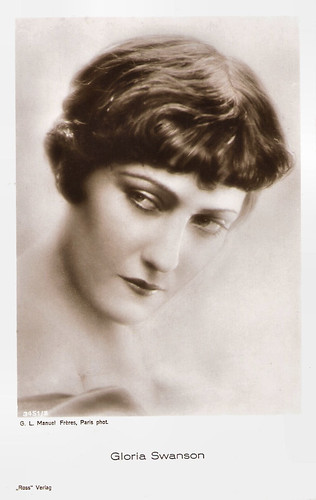
German postcard by Ross Verlag, no. 3451/2, 1928-1929. Photo: G.L. Manuel Frères, Paris.
Gloria Swanson favourite film was Madame Sans-Gêne (Léonce Perret, 1925), the first French-American coproduction in which both countries had a hand in the film’s development. Filming was allowed for the first time at many of the historic sites relating to Napoleon. According to Julie Buck at the Women Film Pioneers Project, “Swanson was deeply involved in every aspect of the production, including having a say in who directed and who was cast.”
Madame Sans-Gêne was well received at the time, but it is now unfortunately considered to be a lost film. During the production, Swanson met her third husband Henri, Marquis de la Falaise, who had been hired to be her translator during the film's production. After a four months residency in France she returned to the United States as European nobility, now known as the Marquise. She got a huge welcome home with parades in both New York and Los Angeles.
Swanson made a number of films for Paramount, among them Stage Struck (Allan Dwan, 1925) and Fine Manners (Richard Rosson, Lewis Milestone, 1926). In 1927, she turned down a million dollar a year contract with Paramount to join the newly created United Artists, where she was her own boss and could make the films she wanted.
Her first independent film, The Love of Sunya, (Albert Parker, 1927) is the story of a young woman granted the ability to see into her future. The production was a disaster and on the advice of Joseph Schenck, Swanson returned to Hollywood.
There she filmed the controversial Sadie Thompson (Raoul Walsh, 1928), based on a story by W. Somerset Maugham. On Broadway it had been a huge hit, but the Hays Office had explicitely banned it. Swanson tricked Hays into giving her permission to shoot and Sadie Thompson became a smash hit. The film made the top ten best pictures of the year list as well and Swanson was nominated for the Best Actress Oscar.
Her next production would become one of the most legendary unfinished films. Queen Kelly (1929) was directed by Erich von Stroheim and produced by Joseph P. Kennedy, Sr., father of the future President John F. Kennedy. Swanson starred in the title role opposite Walter Byron. Production of the costly film was shut down after complaints by Swanson about von Stroheim and the general direction the film was taking. In later interviews, she claimed that she had been misled by the script, which referred to her character arriving in, and taking over, a dance hall. Looking at the rushes, it was obvious the 'dance hall' was actually a brothel.
Von Stroheim was fired from the film. Swanson and Kennedy shot an alternative ending, photographed by Gregg Toland. The film was not theatrically released in the United States due to a clause in Stroheim's contract, but it was shown in Europe and South America with the Swanson ending tacked on. A short extract of the film appears in Sunset Boulevard (Billy Wilder, 1950), representing an old silent picture Swanson's character Norma Desmond had made. Ironically, Von Stroheim is also a primary character in Sunset Boulevard as her ex-director, ex-husband, and current butler.
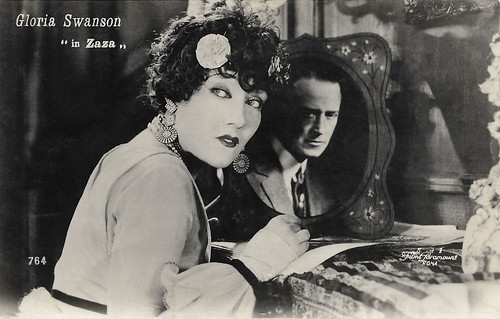
Italian postcard by Ed. Ballerini & Fratini, no. 764. Photo: publicity still for Zazà (Allan Dwan, 1923).
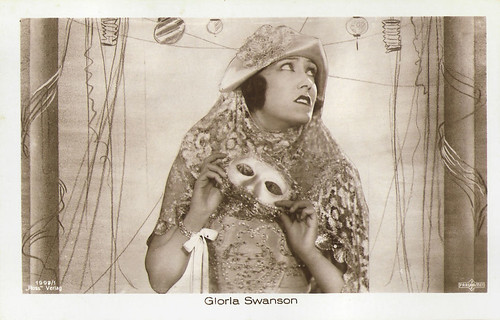
German postcard by Ross Verlag, no. 1997/1, 1927-1928. Photo: Parufamet. Publicity still for Fine Manners (Richard Rosson, Lewis Milestone, 1926).
To try to recover from the Queen Kelly fiasco, Gloria Swanson jumped into making talkies. Her sound debut, The Trespasser (Edmund Goulding, 1929), earned Swanson her second Academy Award nomination, and was a smash hit. Follow-ups like What a Widow! (Allan Dwan, 1930), Indiscreet (Leo McCarey, 1931), and Music in the Air (Joe May, 1934) proved to be box-office flops.
Swanson relocated permanently to New York City in 1938, where she began an inventions and patents company called Multiprises, which kept her occupied during the years of World War II. This small company had the sole purpose of rescuing Jewish scientists and inventors from war-torn Europe and bringing them to the United States. She helped many escape, and some useful inventions came from the enterprise.
Swanson made another film for RKO, Father Takes a Wife (Jack Hively, 1941), began appearing in the legitimate theatre, and starred in her own television show in 1948. She threw herself into painting and sculpting, writing a syndicated column, touring in summer stock, engaging in political activism, radio and television work, clothing and accessories design and marketing, and making occasional appearances on the big screen.
In 1950 she made a glorious come-back with Sunset Boulevard (Billy Wilder, 1950), for which she earned her third Academy Award nomination. After Mae West, Mary Pickford and Pola Negri had declined the role, Swanson portrayed Norma Desmond, a faded silent movie star who falls in love with the younger screenwriter Joe Gillis, played by William Holden. Desmond lives in the past, assisted by her butler Max, played by Erich von Stroheim. Cecil B. DeMille plays himself in a pivotal scene. Some of the lines from the film have become pop-culture mainstays, including "I am big; it's the pictures that got small"; "We didn't need dialogue, we had faces"; and "All right, Mr. DeMille, I'm ready for my close-up."
Swanson received several subsequent acting offers but turned most of them down, saying they tended to be pale imitations of Norma Desmond. Her last major Hollywood role was the poorly received Three for Bedroom "C" (Milton H. Bren, 1952). In Italy, Swanson made the historical comedy Mio figlio Nerone/Nero's Mistress (Steno, 1956), which also starred Alberto Sordi, Vittorio de Sica and Brigitte Bardot. Her final screen appearance was as herself in Airport 1975 (Jack Smight, 1974).
Although Swanson only made three films after Sunset Boulevard, she starred in numerous stage and television productions during her remaining years. She was active in various business ventures, traveled extensively, wrote articles, columns, and an autobiography, painted and sculpted, and became a passionate advocate of various health and nutrition topics. In 1980, Swanson's autobiography, Swanson on Swanson, was published and became a national bestseller. Kevin Brownlow and David Gill interviewed her for the classic TV series Hollywood (1980), a history of the silent era.

French postcard by Ed. Cinémagazine, no. 162. Gloria Swanson in The Humming Bird (Sidney Olcott, 1924), released in France as Les loups de Montmartre.
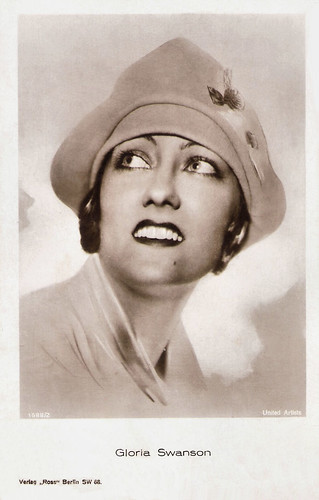
German postcard by Ross Verlag, no. 1588/2, 1927-1928. Photo: United Artists.
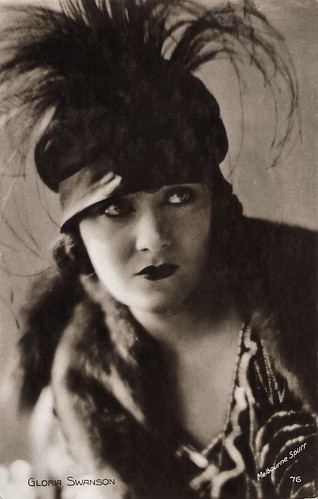
French postcard, no. 76. Photo: Melbourne Spurr.
Throughout her life and her many marriages, Gloria Swanson was always known as Miss Swanson. Though she legally took the names of her husbands, her own personality and fame always overshadowed them. Her first husband was the actor Wallace Beery, whom she married on her 17th birthday. In her autobiography Swanson on Swanson, Swanson wrote that Beery raped her on their wedding night. He also impregnated her in 1917. Not wanting her to have the child, he reportedly tricked her into drinking a concoction that induced an abortion and although they still worked together at Keystone, they separated and finally divorced two years later.
In 1919. she married Herbert K. Somborn, then president of Equity Pictures Corporation and later the owner of the Brown Derby restaurant. They had a daughter, Gloria Swanson Somborn (1920-2000) and Swanson adopted a baby boy, Sonny Smith (1922–1975), whom she renamed Joseph Patrick Swanson. Her divorce from Somborn in 1925 was sensational when he accused her of adultery with thirteen men including Cecil B. DeMille, Rudolph Valentino, and director Marshall Neilan.
Swanson's third husband was the French aristocrat Henri, Marquis de la Falaise de la Coudraye, whom she married after the Somborn divorce was finalized. Swanson was the first film star to marry European nobility, and the marriage became a global sensation. She conceived a child with him, but had an abortion, which, in her autobiography, she said she regretted. Later, Henri became a film executive representing Pathé (USA) in France through Joseph P. Kennedy, Sr., who was running the studio. This marriage ended in divorce in 1930. Soon after, Henri remarried, to actress Constance Bennett.
While still married to Henri, Swanson had an affair with the married Joseph P. Kennedy for a number of years. He became her business partner and their relationship was an open secret in Hollywood. He took over all of her personal and business affairs and was supposed to make her millions. Unfortunately, Kennedy left her after the disastrous Queen Kelly and her finances were in worse shape than when he came into her life.
In 1931, Swanson married Michael Farmer with whom she had a daughter, Michelle Bridget Farmer (1932). Swanson and Farmer divorced in 1934, after she became involved with married British actor Herbert Marshall. The media reported widely on the and after almost three years, Swanson left him once she realized he would never divorce his wife, Edna Best, for her. In 1945, Swanson married William N. Davey but divorced him in 1946.
For the next thirty years Swanson would remain unmarried and able to pursue her own interests. Swanson's final marriage, to writer William Dufty, occurred in 1976 and lasted until her death. In 1983, Gloria Swanson died in New York City in New York Hospital from a heart ailment, aged 84. Miss Swanson was survived by both of her daughters (her son had died in 1975), several grandchildren, and great-grandchildren in the United States and France.
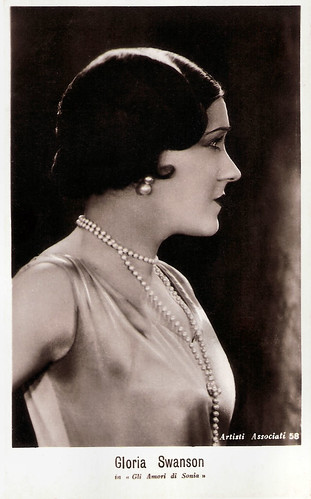
Italian postcard, no. 58. Photo: Artisti Associati (United Artists). Publcity still for The Love of Sunya (Albert Parker, 1927).

Austrian postcard by Iris Verlag, no. 904. Photo: United Artists / Verleih Projectograph-Film.
Trailer for Madame Sans-Gêne (1925). Source: historycomestolife (YouTube).
Sources: Julie Buck (Women Film Pioneers Project), Ed Stephan (IMDb), Wikipedia and IMDb.

German postcard by Ross Verlag, no. 1488/3, 1927-1928. Photo: Paramount / Parafumet. Publicity still for Stage Struck (Allan Dwan, 1925).

Italian postcard, no. 139. Photo: Films Paramount Roma. Publicity still for Madame Sans-Gêne (Léonce Perret, 1925) with Emile Drain. Collection: Didier Hanson.

Spanish postcard by Casa Molina, Madrid. Gloria Swanson and Walter Byron in Queen Kelly (Erich von Stroheim, 1929).
The Lion's Bride
Gloria May Josephine Swanson was born in Chicago in 1899 to Adelaide (née Klanowski) and Joseph Theodore Swanson, a soldier. (Some sources list 1897 as the year of her birth.) Because of her father's attachment to the U.S. Army, the family moved frequently and Swanson ended up spending most of her childhood in Puerto Rico, where she learned Spanish. She also spent time in Key West, Florida.
It was not her intention to enter show business, but on a whim one of her aunts took her to a small film company in Chicago called Essanay Studios for a visit and Swanson was asked to come back to work as an extra. According to Wikipedia, she made her film debut there in the short The Song of Soul (1914) and according to Ed Stephan at IMDb in The Fable of Elvira and Farina and the Meal Ticket (Richard Foster Baker, 1915).
After a few months working as an extra, Swanson left school to work full-time at Essanay. She auditioned for the leading female role opposite Charlie Chaplin in His New Job (Charles Chaplin, 1915), but he instead cast her in the brief role of a stenographer. Her parents separated and she and her mother moved to California in 1916. There she appeared in Mack Sennett's Keystone comedies opposite Bobby Vernon.
In 1919 she signed a seven-year contract with Famous Players-Lasky. There director Cecil B. DeMille turned her into a romantic lead in such films as Don't Change Your Husband (1919), Male and Female (1919) with the famous scene posing as ‘the Lion's Bride’ with a real lion, Why Change Your Wife? (1920), Something to Think About (1920), and The Affairs of Anatol (1921).
In only two years, Swanson rocketed to stardom and became one of the most sought-after actresses in Hollywood. She next appeared in a series of films directed by Sam Wood, including Beyond the Rocks (1922) with Rudolph Valentino. Long believed to be a lost film, Beyond the Rocks was rediscovered in 2004 in The Netherlands. In a series of costume dramas, Swanson became the screen's first clotheshorse, ornamented with beads, jewels, peacock and ostrich feathers, and other extravagant pieces haute couture of the day.

German postcard by Ross Verlag, Berlin, no. 1091/1, 1927-1928. Photo: Paramount-Film. Publicity still for Beyond the Rocks (Sam Wood, 1922) with Rudolph Valentino.

German postcard by Ross Verlag, no. 3451/1, 1928-1929. Photo: G.L. Manuel Frères, Paris.

German postcard by Ross Verlag, no. 3451/2, 1928-1929. Photo: G.L. Manuel Frères, Paris.
One of the most legendary unfinished films
Gloria Swanson favourite film was Madame Sans-Gêne (Léonce Perret, 1925), the first French-American coproduction in which both countries had a hand in the film’s development. Filming was allowed for the first time at many of the historic sites relating to Napoleon. According to Julie Buck at the Women Film Pioneers Project, “Swanson was deeply involved in every aspect of the production, including having a say in who directed and who was cast.”
Madame Sans-Gêne was well received at the time, but it is now unfortunately considered to be a lost film. During the production, Swanson met her third husband Henri, Marquis de la Falaise, who had been hired to be her translator during the film's production. After a four months residency in France she returned to the United States as European nobility, now known as the Marquise. She got a huge welcome home with parades in both New York and Los Angeles.
Swanson made a number of films for Paramount, among them Stage Struck (Allan Dwan, 1925) and Fine Manners (Richard Rosson, Lewis Milestone, 1926). In 1927, she turned down a million dollar a year contract with Paramount to join the newly created United Artists, where she was her own boss and could make the films she wanted.
Her first independent film, The Love of Sunya, (Albert Parker, 1927) is the story of a young woman granted the ability to see into her future. The production was a disaster and on the advice of Joseph Schenck, Swanson returned to Hollywood.
There she filmed the controversial Sadie Thompson (Raoul Walsh, 1928), based on a story by W. Somerset Maugham. On Broadway it had been a huge hit, but the Hays Office had explicitely banned it. Swanson tricked Hays into giving her permission to shoot and Sadie Thompson became a smash hit. The film made the top ten best pictures of the year list as well and Swanson was nominated for the Best Actress Oscar.
Her next production would become one of the most legendary unfinished films. Queen Kelly (1929) was directed by Erich von Stroheim and produced by Joseph P. Kennedy, Sr., father of the future President John F. Kennedy. Swanson starred in the title role opposite Walter Byron. Production of the costly film was shut down after complaints by Swanson about von Stroheim and the general direction the film was taking. In later interviews, she claimed that she had been misled by the script, which referred to her character arriving in, and taking over, a dance hall. Looking at the rushes, it was obvious the 'dance hall' was actually a brothel.
Von Stroheim was fired from the film. Swanson and Kennedy shot an alternative ending, photographed by Gregg Toland. The film was not theatrically released in the United States due to a clause in Stroheim's contract, but it was shown in Europe and South America with the Swanson ending tacked on. A short extract of the film appears in Sunset Boulevard (Billy Wilder, 1950), representing an old silent picture Swanson's character Norma Desmond had made. Ironically, Von Stroheim is also a primary character in Sunset Boulevard as her ex-director, ex-husband, and current butler.

Italian postcard by Ed. Ballerini & Fratini, no. 764. Photo: publicity still for Zazà (Allan Dwan, 1923).

German postcard by Ross Verlag, no. 1997/1, 1927-1928. Photo: Parufamet. Publicity still for Fine Manners (Richard Rosson, Lewis Milestone, 1926).
A glorious come-back
To try to recover from the Queen Kelly fiasco, Gloria Swanson jumped into making talkies. Her sound debut, The Trespasser (Edmund Goulding, 1929), earned Swanson her second Academy Award nomination, and was a smash hit. Follow-ups like What a Widow! (Allan Dwan, 1930), Indiscreet (Leo McCarey, 1931), and Music in the Air (Joe May, 1934) proved to be box-office flops.
Swanson relocated permanently to New York City in 1938, where she began an inventions and patents company called Multiprises, which kept her occupied during the years of World War II. This small company had the sole purpose of rescuing Jewish scientists and inventors from war-torn Europe and bringing them to the United States. She helped many escape, and some useful inventions came from the enterprise.
Swanson made another film for RKO, Father Takes a Wife (Jack Hively, 1941), began appearing in the legitimate theatre, and starred in her own television show in 1948. She threw herself into painting and sculpting, writing a syndicated column, touring in summer stock, engaging in political activism, radio and television work, clothing and accessories design and marketing, and making occasional appearances on the big screen.
In 1950 she made a glorious come-back with Sunset Boulevard (Billy Wilder, 1950), for which she earned her third Academy Award nomination. After Mae West, Mary Pickford and Pola Negri had declined the role, Swanson portrayed Norma Desmond, a faded silent movie star who falls in love with the younger screenwriter Joe Gillis, played by William Holden. Desmond lives in the past, assisted by her butler Max, played by Erich von Stroheim. Cecil B. DeMille plays himself in a pivotal scene. Some of the lines from the film have become pop-culture mainstays, including "I am big; it's the pictures that got small"; "We didn't need dialogue, we had faces"; and "All right, Mr. DeMille, I'm ready for my close-up."
Swanson received several subsequent acting offers but turned most of them down, saying they tended to be pale imitations of Norma Desmond. Her last major Hollywood role was the poorly received Three for Bedroom "C" (Milton H. Bren, 1952). In Italy, Swanson made the historical comedy Mio figlio Nerone/Nero's Mistress (Steno, 1956), which also starred Alberto Sordi, Vittorio de Sica and Brigitte Bardot. Her final screen appearance was as herself in Airport 1975 (Jack Smight, 1974).
Although Swanson only made three films after Sunset Boulevard, she starred in numerous stage and television productions during her remaining years. She was active in various business ventures, traveled extensively, wrote articles, columns, and an autobiography, painted and sculpted, and became a passionate advocate of various health and nutrition topics. In 1980, Swanson's autobiography, Swanson on Swanson, was published and became a national bestseller. Kevin Brownlow and David Gill interviewed her for the classic TV series Hollywood (1980), a history of the silent era.

French postcard by Ed. Cinémagazine, no. 162. Gloria Swanson in The Humming Bird (Sidney Olcott, 1924), released in France as Les loups de Montmartre.

German postcard by Ross Verlag, no. 1588/2, 1927-1928. Photo: United Artists.

French postcard, no. 76. Photo: Melbourne Spurr.
Forever Miss Swanson
Throughout her life and her many marriages, Gloria Swanson was always known as Miss Swanson. Though she legally took the names of her husbands, her own personality and fame always overshadowed them. Her first husband was the actor Wallace Beery, whom she married on her 17th birthday. In her autobiography Swanson on Swanson, Swanson wrote that Beery raped her on their wedding night. He also impregnated her in 1917. Not wanting her to have the child, he reportedly tricked her into drinking a concoction that induced an abortion and although they still worked together at Keystone, they separated and finally divorced two years later.
In 1919. she married Herbert K. Somborn, then president of Equity Pictures Corporation and later the owner of the Brown Derby restaurant. They had a daughter, Gloria Swanson Somborn (1920-2000) and Swanson adopted a baby boy, Sonny Smith (1922–1975), whom she renamed Joseph Patrick Swanson. Her divorce from Somborn in 1925 was sensational when he accused her of adultery with thirteen men including Cecil B. DeMille, Rudolph Valentino, and director Marshall Neilan.
Swanson's third husband was the French aristocrat Henri, Marquis de la Falaise de la Coudraye, whom she married after the Somborn divorce was finalized. Swanson was the first film star to marry European nobility, and the marriage became a global sensation. She conceived a child with him, but had an abortion, which, in her autobiography, she said she regretted. Later, Henri became a film executive representing Pathé (USA) in France through Joseph P. Kennedy, Sr., who was running the studio. This marriage ended in divorce in 1930. Soon after, Henri remarried, to actress Constance Bennett.
While still married to Henri, Swanson had an affair with the married Joseph P. Kennedy for a number of years. He became her business partner and their relationship was an open secret in Hollywood. He took over all of her personal and business affairs and was supposed to make her millions. Unfortunately, Kennedy left her after the disastrous Queen Kelly and her finances were in worse shape than when he came into her life.
In 1931, Swanson married Michael Farmer with whom she had a daughter, Michelle Bridget Farmer (1932). Swanson and Farmer divorced in 1934, after she became involved with married British actor Herbert Marshall. The media reported widely on the and after almost three years, Swanson left him once she realized he would never divorce his wife, Edna Best, for her. In 1945, Swanson married William N. Davey but divorced him in 1946.
For the next thirty years Swanson would remain unmarried and able to pursue her own interests. Swanson's final marriage, to writer William Dufty, occurred in 1976 and lasted until her death. In 1983, Gloria Swanson died in New York City in New York Hospital from a heart ailment, aged 84. Miss Swanson was survived by both of her daughters (her son had died in 1975), several grandchildren, and great-grandchildren in the United States and France.

Italian postcard, no. 58. Photo: Artisti Associati (United Artists). Publcity still for The Love of Sunya (Albert Parker, 1927).

Austrian postcard by Iris Verlag, no. 904. Photo: United Artists / Verleih Projectograph-Film.
Trailer for Madame Sans-Gêne (1925). Source: historycomestolife (YouTube).
Sources: Julie Buck (Women Film Pioneers Project), Ed Stephan (IMDb), Wikipedia and IMDb.
1 comment:
I am just in awe of this post, Paul. What an incredible woman she was! I had never heard of her, though I am acquainted with Cecil DeMil (sp). You are an incredible historian. I am so honored to know you.
Our sons are close in age. My youngest is 26. He is an amazing young man. I hope you all had a wonderful time with Mr. James Bond. :D
I think of you and your family with great warmth.
Post a Comment